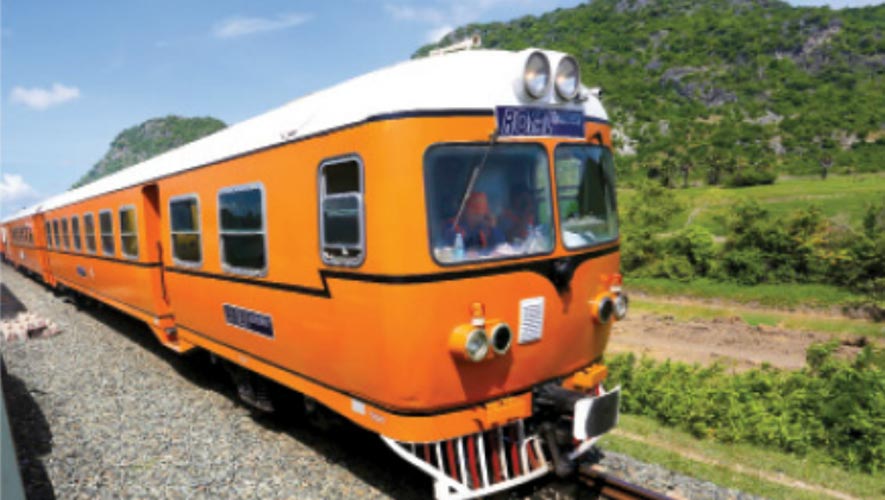Cambodia can expect high speed rail service and double tracking with Royal Railway Co Ltd’s tie up with state-owned China Railway Construction Co Ltd (CRCC) as the local rail company moves to expand its inventory and network in the near future.
For the latest Cambodian Business news, visit Khmer Times Business
Royal Railway chief executive officer John Guiry says the company is buying 10 locomotives from India, and motorised passenger cars from Mexico because of the anticipated growth in both rail freight and passenger.
“The business is growing and we want to expand our services. Currently, we have 250 wagons and 12 locomotives. The railway is a major transport component in Cambodia which supports the country’s growth,” he tells Capital Cambodia.
The railway, expected to spend some $27 million for the rolling stock, operates 44 trips daily including shuttles to Phnom Penh International Airport, and 15 to 16 freight deliveries to Sihanoukville and Poipet. A majority of its revenue is derived from the freight service with less than one percent from passenger movement.
“The trains are full and there is not much room to grow. We need more locomotives. At present, only half of them are overhauled. We have a lot of maintenance work to do,” Guiry says.
There is a high potential for revenue growth with the increase in rolling stock. “If we run our train to Sihanoukville four times a day, that is four times the revenue,” he adds.
Rail history and future
The Cambodian railway has had an interesting past after the French government built the rail service between Phnom Penh and Poipet in the 1930s. The second line from Phnom Penh and Sihanoukville was constructed in the 1960s. Both lines were suspended during the Khmer Rouge in the 1970s, and resumed in the 1980s.
Royal Railway’s debut dates back to 2009, when the government signed a 30-year concession agreement that allowed Toll Cambodia Co Ltd – a joint venture between Australia-based Toll Holding Ltd and Royal Group of Companies Ltd at a 48:52 equity, respectively, to manage the operation of the railway system in Cambodia.
In 2014, Toll Holding transferred all its shares to its local partner, making Royal Group the sole shareholder. The company was renamed Royal Railway Cambodia. Since then more than $226.5 million has been spent to restore the southern line which connects Phnom Penh and Sihanoukville, and the northern line running from Phnom Penh to Poipet. About $85 million came out of the national budget while the rest was lent by Asian Development Bank, and other development partners.
At the recent Belt and Road Initiative Forum, Prime Minister Hun Sen sought the help of Shanghai-listed CRCC to make the railway system efficient. An 18-member CRCC team arrived in Phnom Penh last week to start feasibility studies on improving the railway, and building a monorail and a subway to better the public transportation service in the city.
The move to revamp the railway service came on the heels of Hun Sen’s alleged termination of Royal Railway’s contract. He had also earmarked an allocation of $100 million to improve the service. However, he recanted the instruction soon after, saying that his words were misunderstood. In any case, Hun Sen said the government was not capable to take over an operating railway service as it did not have the capacity, hence the assistance sought from CRCC.
“We have to find a new company that can partner with Royal Railway and is able to invest capital into the railroad system to improve the lines. Our goal is to reform and modernise the railway system, making the two lines run efficient,” he said.
Ready to roll
Meanwhile, Guiry says that the railway is at an upgrading stage as rehabilitation is over. “The tracks have to be faster and the railway line has to be better. We can do 100 kilometres per hour but we slow down at some sections because it passes through villages.
“We are also trying to get rid of faulty tracks that were put in during the French era. We have hit cows and water buffaloes that can derail a train and badly damage it.
“So, we have to prioritise repairs and it takes a long time to get your money back. Everything is an investment in the railway including salary, staff (training),” he adds.
Guiry says the company is ready to work with CRCC and share information on the feasibility study. “There are four piles of document for them to look through. We will have to look at the railway line to increase the speed. There are other things to look at also, for example the rebuilding of a bridge, and when we are ready to go ahead with the tracks. It is all about planning and that is what we are going to talk about with CRCC,” he adds.




